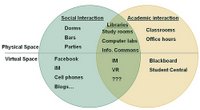First, from the library and information science perspective:
Joyce Saricks had a column on the April 1, 2006 issue of Booklist entitled "Rules for Readers--and That Means Librarians, Too!" I read it via the old library routing, which explains why it took me a while to get to it. Now, my two readers know that I pretty much prefer to throw rules out when I can, but I found the article to be a nice affirmation of things I do as a reader. When it comes to reading, I am a bit eclectic, a mixed bag. Sure, there are things I enjoy regularly, but I wander now and then. Since life is short, I don't believe in wasting time on a bad book. Saricks cites Nancy Pearl's 50 page rule. I will usually try to give a book the 50 page chance, but if it loses me on page 25, it's gone. I used to feel a need to read cover to cover. Not anymore. I am now a liberated reader. continue reading
Having written a few months back about rules for readers and readers’ advisors, I’m having second thoughts. Not about the ideas expressed but about the whole concept of rules in relation to readers’ advisory—especially since our field is refreshingly nonprescriptive. One of the reasons for the current renaissance is that librarians who are practicing and writing about readers’ advisory advocate guidelines and suggestions, not rules. continue reading from At Leisure with Joyce Saricks: Against Rules
February 22, 2002 "3 Minute Reader's Advisory for the harried and hurried Held at Multnomah County Central Library. Presentions by Robin Beerbower, Salem Public Library, Ruth Allen and Allison Kastner, both from Multnomah County Library. Over 70 attended.
ALBANY, Ga. (AP) — Patrons of the Dougherty County Library get an e-mail each day featuring one or more chapters from a selected book.
These "five-minute reads" may persuade the readers to check the book out from the library or go to a bookstore and buy it. If nothing else, they can share their thoughts on the book with other readers on the library's Web site.
Once again we've taken advantage of our illicit love affair with RevolutionSF to get a podcast of our recent reading out there on that Internet thing. Give it a listen - each reading only lasts two minutes, so get over yourself already.
Rules for journalists, writers, documentation specialists, etc. on readability:
Write the way people read.
The 30-3-30-3 guideline:
30-second reader skims bullets and short lists.
3-minute reader reads headlines, blurbs, captions and callout boxes.
30-minute reader reads short articles and searches the publication for more information.
3-hour reader wants white papers, research results… hefty reading material. keep reading about readership
the 30-minute reader who will read the full text,
the 3 minute reader who scans the material, and
the 30-second reader who reads only the headings as they put it in the trash. keep going here
Begin your discussion of news writing with a consideration of the different kinds of newspaper readers. For the sake of argument, we can identify three: the 30-second reader, the 3-minute reader, and the 30-minute reader. All of us fall into each of these categories at one time or another.
The 30-second reader is in a rush, possibly grabbing a quick look at the paper while eating a donut and rushing out the door to school or work. This reader has time only to scan a few headlines and glance at a few pictures.
The 3-minute reader is also in a rush, though she may have time enough to sit down while she looks at the paper. This reader does all the things that the 30-second reader does, plus she reads the beginning paragraphs (the leads) of a few interesting stories.
Finally, the 30-minute reader (get a life!) finds time enough to do everything our first two readers did plus actually read a few stories from beginning to end. This is where the importance of inverted pyramid writing (a topic we will cover soon) comes to the fore. continue reading
"The Internet is for everybody. It's for the 30-second reader; the three-minute reader; the 30- minute reader and even the three-hour junkie. Like the rest of cyberland, though, it's full of branches and nests (and even nests within nests). Open (on home pages, etc.) with kernels for the 30-second reader. Break to bits for the three-minute reader. Branch to detail for the 30-minute reader. Link to verbal and visual feasts for the three-hour junkie." continue reading:
See my previous post on Reader's Advisory





